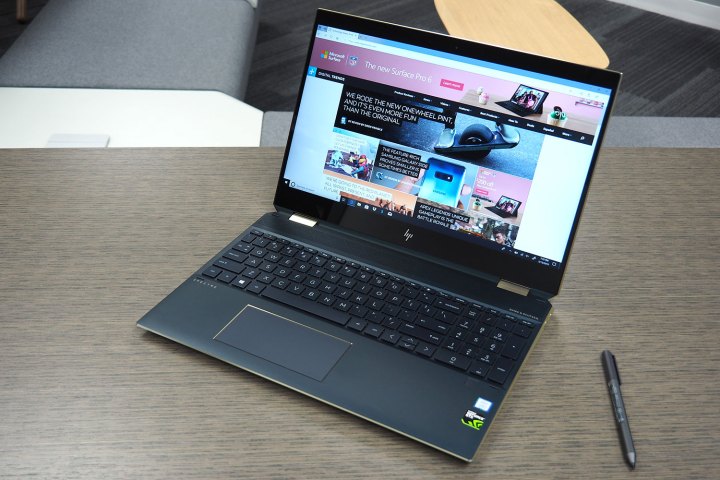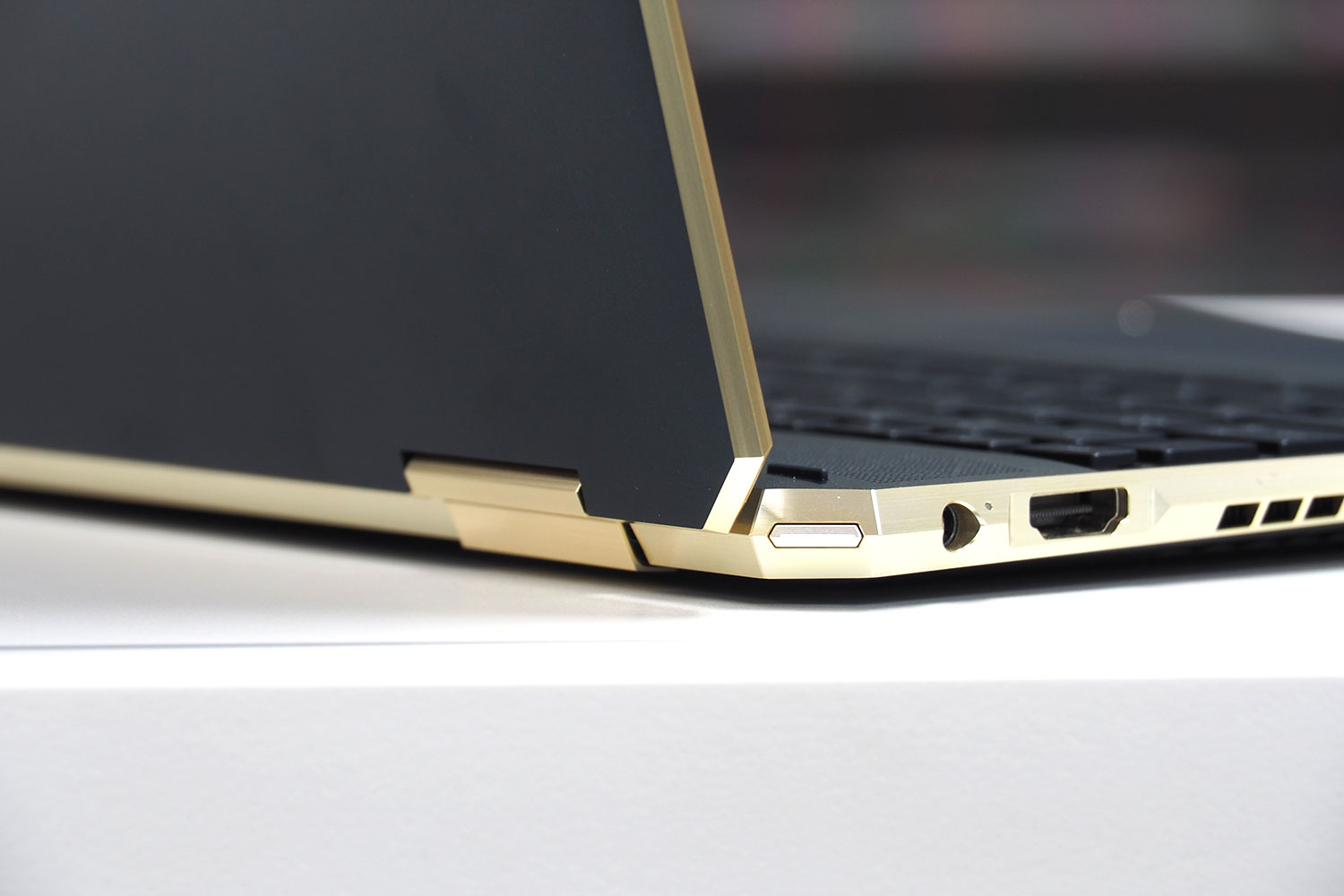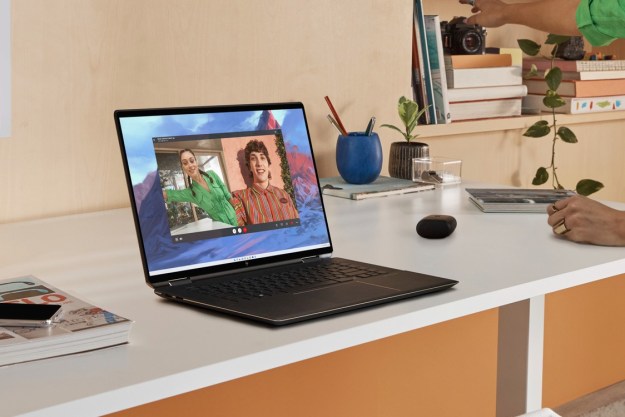
There was a time when 2-in-1 laptops, which can convert from a clamshell facsimile to a tablet with a couple of modes in between, weren’t the best options for power users. Even 15-inch 2-in-1s lacked the kind of components that creative professionals and those who need fast CPUs and GPUs were looking for.
That’s no longer the case. Today, you can choose from several 2-in-1s that offer powerful silicon and excellent displays, making them viable alternatives to 15-inch clamshells for power users as well as those seeking the most flexibility. Here, we compare two great examples, the HP Spectre x360 15 and the Lenovo Yoga c940 15.
Design

There’s no doubt about it: The Spectre x360 15 enjoys a more extravagant design, with a “gem-cut” aesthetic where every edge — the lid, the chassis, even the keyboard deck — is chiseled to look like a finely cut diamond. Two color options, Poseidon Blue and Dark Ash Silver, add some splash to the design that make it far more striking than the more conservatively styled Lenovo Yoga C940. The new Spectre that’s coming in February even includes significantly cut down bezels for a smaller overall footprint. There’s nothing wrong with the Yoga’s look, and some people might prefer its more subdued elegance.
Both 2-in-1s are well built, with very little if any flex in the lid, keyboard deck, and chassis bottom. If there’s one area where the two designs differ in the most meaningful way, it’s that the Yoga C940 benefits from smaller bezels and therefore a smaller chassis. The Yoga is also lighter at 4.18 pounds versus the HP’s 4.81 pounds, and it’s tapered and so seems quite a bit thinner — in spite of the fact that at its thickest point of 0.77 inches, the Yoga is actually a tiny bit thicker than the Spectre x360’s 0.76 inches.
If keyboard quality matters, then you’ll be happy with both 2-in-1s. We do prefer the HP’s deeper travel and more precise mechanism to the Yoga’s shallower and less clicky version, but touch typists will get up to speed with both in short order. The Yoga C940 does benefit from its Microsoft Precision touchpad drivers versus the Spectre x360’s Synaptics drivers that aren’t nearly as responsive. That’s another thing that’s changed in the new model, available in February.
Both 2-in-1s have responsive touch displays and quite usable active pens, but the latter represents a trade-off. The Yoga’s pen fits into a socket in the chassis and automatically charges when inserted, but it’s smaller. The Spectre x360’s larger and more comfortable pen but it has no such receptacle and has to be charged separately.
Connectivity is another Spectre x360 strength. If offers two USB-C with 40 gigabit per second (40Gbps) Thunderbolt 3 support, a single USB-A 3.1 port, and a full-size HDMI port. The Yoga C940 also has two Thunderbolt ports and a single USB-A port, but it skips the HDMI port. The Spectre x360 also supports two 5K displays at once. Wireless connectivity is Wi-Fi 6 on the Yoga C940 via an Intel AX200 Wi-Fi card with Bluetooth 5.0, but only Wi-Fi 5 and Bluetooth 5 on the Spectre x360.
Performance

Both 2-in-1s offer 45-watt six-core Intel Core i7 processors for excellent CPU performance. The Spectre x360 15 is limited to the 9th-generation Intel Core i7-9750H CPU, while the Yoga C940 15 can be configured with up to a 9th-gen Core i9-9880H with vPro. That gives the Yoga C940 more headroom. Note that the Spectre x360 15 can also be configured with a 10th-gen Comet Lake Core i7-10510U, which is a 15-watt quad-core CPU that’s fast but won’t keep up with the 45-watt parts.
Both laptops can also be configured with the same Nvidia GeForce GTX 1650 GPU, which offers decent midrange gaming in modern titles at 1080p and medium graphics. The Spectre x360 can also be configured with an Nvidia GeForce MX250.
Their displays are where these laptops digress. The Spectre x360 has a decent touch- and pen-enabled 4K (3,840 x 2,160) IPS display that average colors (73 percent of AdobeRGB), good contrast, and just below our preferred 300 nits of brightness. However, HP also offers the laptop with a 15.6-inch AMOLED display that has some of the best brightness, color accuracy, and contrast you’ll find in a 15-inch laptop.
The Yoga C940 offers two display options, a Full HD (1,920 x 1,080) that promises 500 nits and supports Dolby Vision high dynamic range (HDR), as well as a 4K display that’s also bright, has good colors and contrast (but not nearly as good as the HP’s AMOLED display), and Dolby Vision HDR. Creative professionals will find the AMOLED display to be a far superior option, although there’s a price to pay in battery life.
The Yoga C940 can run faster than the Spectre x360 15, but the HP is plenty fast and offers a vastly superior display. Ultimately, it’s the better choice for creative types.
Portability

Let’s face it: Both of these 2-in-1s will weigh you down. And, neither is very comfortable in tablet mode unless they’re lying on a desk or propped up in a user’s lap.
Battery life, therefore, becomes the more pressing portability concern. The Spectre x360 13 has an 82 watt-hour battery tucked away inside, while the Yoga C940 is limited to just 69 watt-hours. Not surprisingly, that gives the HP the edge — unless you configure it with the power-hungry AMOLED display versus the Yoga C940’s Full HD display.
We compared the 4K versions with 45-watt CPUs, and the HP lasted for 80 minutes longer in our web benchmark and two ours longer in our local video test. The Spectre x360 AMOLED version would likely fall behind, and the Yoga C940’s Full HD display would likely make up some ground. The new Spectre does include an option for a 1-watt
The buyer therefore has a choice to make with either machine: Choose a power-hungry display and give up battery life, or drop down a notch and have a longer-lasting 2-in-1.
The Spectre x360 15’s AMOLED display gives it a slight edge

The Spectre x360 has a reasonable starting price of $1,550 ($1,300 on sale) for a Core i7-9750H, 8GB of RAM, a 256GB PCIe solid-state drive (SSD), and the 4K IPS display, and goes all the way up to $2,320 ($2,070 on sale) with a 2TB SSD and the
The Yoga C940 is similarly priced but is more powerfully configured, at $1,740 ($1,295 on sale for a Core i7-9750H, 12GB of RAM, a 512GB SSD, and a Full HD display. It ranges up to $2,700 ($2,160 on sale) for a Core i9-9880H, 16GB of
The Yoga C940 is slightly faster than the Spectre x360 15 in its maximum configuration, but the HP offers a much better display and more battery capacity. Both will serve creative professionals well, but the Spectre x360 15 will simply be more pleasing to the eye.
Editors' Recommendations
- Best Lenovo laptop deals: Save on Yoga and ThinkPad laptops
- HP’s new Envy x360 14 looks like a killer value for what you get
- Asus ZenBook S 13 Flip vs. HP Envy x360 13: it comes down to price
- New HP Spectre x360 16 ditches Nvidia, embraces Intel Arc
- Lenovo ThinkPad X12 Detachable vs. Microsoft Surface Pro 8


